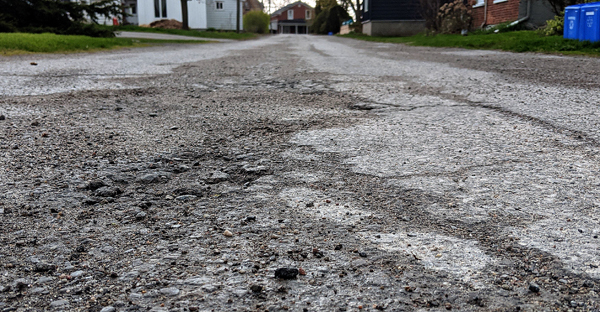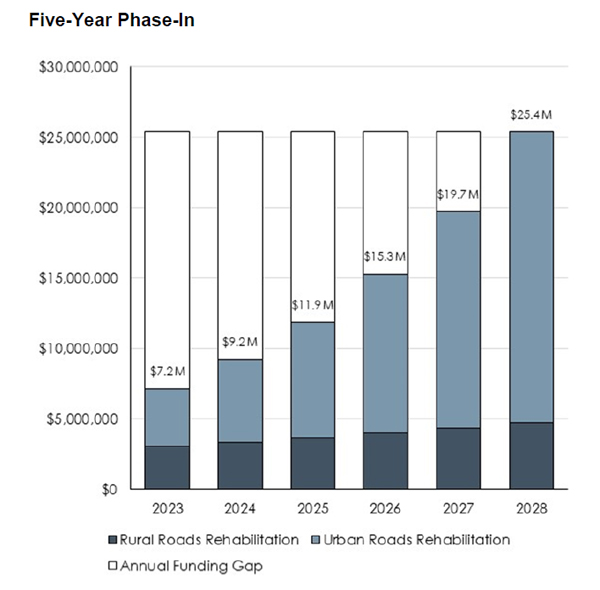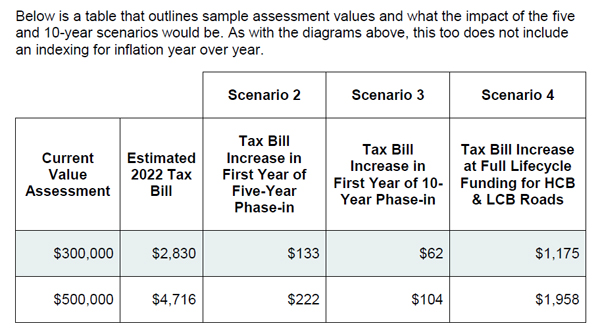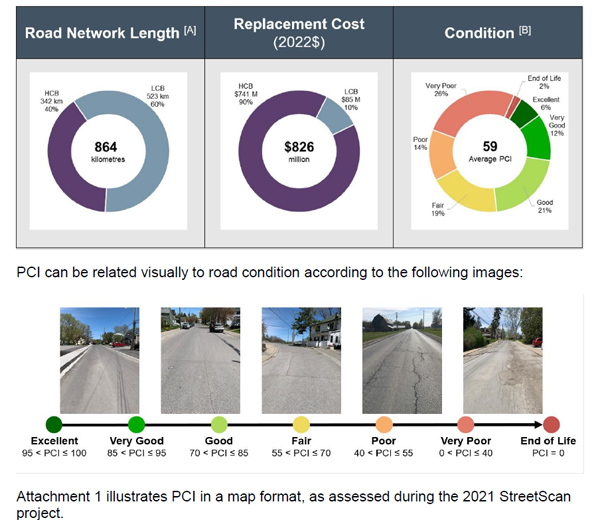Money, money and more money only solution to start improving County roads
Administrator | Jan 12, 2023 | Comments 9
 Both the County and its taxpayers are between a rock and a hard place when it comes to funding to fix the municipality’s 1,047 kilometers of roads – but council sees some light in a five-year tunnel.
Both the County and its taxpayers are between a rock and a hard place when it comes to funding to fix the municipality’s 1,047 kilometers of roads – but council sees some light in a five-year tunnel.
Prince Edward County staff presented council with four roads scenarios at its committee of the whole meeting Thursday, and development of a five-year capital plan was chosen to be considered as part of the 2023 budget talks in February. The decision will move to council’s regular meeting Jan. 24.
With agreement among councillors that roads have been chronically underfunded over the years, the County’s CAO Marcia Wallace noted the plan will start to “get us out of a hole that is quite deep”.
She added that programs for assistance from other levels of government do not appear to be on the horizon any time soon, as they have been in past years with shared one-third cost agreements. However, she noted, asks by staff and the mayor continue at all appropriate avenues.
The funding level to achieve the desired lifecycle funding for roads is $25.4 million annually, relative to current investment of approximately $7 million. Investment ramp-up would begin in 2024.
 While planning occurs with a multi-year focus, council is only able to make budget decisions for the current year under the Municipal Act.
While planning occurs with a multi-year focus, council is only able to make budget decisions for the current year under the Municipal Act.
Future budgets will be assessed based on the revenue generated and costs in that given year. Tax and other revenue are expected to increase due to growth (more tax payers) and higher property assessment values expected in 2024 from the Municipal Property Assessment Corporation, MPAC, which is out of the County control.
Excluding the County’s gravel roads (164 km) and Highway 49 (an 18 km concrete roadway) there are 864 kilometres of roads (varying from end-of-life to excellent condition) and it is estimated it would cost $826 million to replace them. The Highway 49 estimate alone has been pegged at around $25 million.
Councillors also noted that when the time comes, discussions could involve returning more roads back to gravel state.
Of the four scenarios presented, council agreed with staff that the five-year scenario strikes the best balance between required level of funding and the resulting improvement to the condition of the road network.
The first, status quo scenario, and last, single step increase, were not recommended by staff, leaving the five-year, and 10-year scenarios.
It was noted that under all scenarios, the condition of the roads will continue to deteriorate before improvement is realized and as a result, there are also future budget implications for pot hole patching, staffing, equipment and materials. In addition, as roads deteriorate more rapidly as they age, other related costs such as culverts and storm sewer infrastructure will also need to be included in budgeting.
All costs are not fully borne by the roads budget as some are shared with water and waste water and growth related will be funded by development charges.
Staff also noted the municipality received 54 claims in 2022 due to vehicle damage related to poor road quality here. Of the claims processed to date, 21 (43 per cent)were denied on the basis that the County was keeping up on its minimum maintenance standards. Of those paid out, the average claim was $624.21 for a total of $13,108.49 paid in 2022.

Sample assessment values and the impact of the five and 10-year scenarios. All numbers are not indexed for inflation. Also unknown is the increase in the levy based on the coming update of property assessments by the Municipal Property Assessment Corporation (out of County control). Property assessment, on which tax payments are based, have not been updated since 2016 due to the pandemic, but are expected to be updated by MPAC in 2024.
Decisions made for the 2023 budget will inform specific road projects and the financing strategy.
The County’s tax supported entire capital budget (roads, bridges, emergency vehicles and other assets for services and programs) adopted in 2022 was $18.5 million.
The County is responsible for the maintenance and lifecycle management of 1,047 kilometers of public roads – 90 per cent rural and just under half are paved with surface treatment known as tar and chip. Some 342 km are surfaced with asphalt, or High Class Bituminous (HCB) material and 523 km are paved with surface treatment, or Low Class Bituminous (LCB) material.
State-of-the-art computer modeling software was used to help determine long-term funding and service level scenarios.
Councillors John Hirsch and Phil St.-Jean noted they were impressed by the computer software they felt provided a science-based “roadmap” to get where the County needs to go for better roads.
Instead of simply worst roads first as in past years, the models take into account roads that work would support benefits, help flooding, or have an historic high volume of calls for emergency services and also those where an upgrade would result in increased local benefit – such as low volume rural roads with a higher density of properties or driveways.
Field condition assessments of all municipal roadways were completed in 2021 by StreetScan, a company that inspects roads using state-of-the-art mobile sensing technology and provides detailed visual records.
The Pavement Condition Index (PCI) is calculated from three factors:
1. The physical condition of the surface
2. A rating of the ride comfort
3. A calibration coefficient based on the surface type.
The PCI calculations are classified into ranges, which are then assigned a grade to create an overall picture of the health of the road network.
Excluding the County’s gravel roads (164 km) and Highway 49 (an 18 km concrete roadway), and adjusted for assumed degradation since 2021 and including work completed in 2022, the current network length, replacement cost, and condition of HCB and LCB roads are indicated below:

The current average Pavement Condition Index (PCI) is 59.
“With the 10-year phase-in scenario, average PCI decreases for a longer period of time before increasing, where conversely the five-year phase-in scenario rises far more quickly over the same period of time. Stated simply, the condition of the County road network improves more rapidly with the five-year phase-in scenario than the 10-year option,” the report states.
Adam Goheen, Director of Operations, notes that in the five-year phase-in to target-level funding, the level of service (PCI) would decline initially from 59 in 2022 to 56 by 2025 but would start to improve thereafter. The proportion of roads in end-of-life condition would increase from two per cent currently to a high of 17 per cent in the early 2030s. However, the target funding level would allow The County to maintain an average PCI of 83 over the long run.
“This is a very aggressive ramp-up of funding – three-and-a-half times our current spending. We will all see tangible and measurable improvements.”
Click here for the full report on the Committee of the Whole agenda
Filed Under: Featured Articles • Local News
About the Author:

































It seems illogical to tear out the entire County Rd 49 concrete base, much of which is still functional if there is a practical application to restore.
ADJ
The county just now are using a asphalt hot box to repair pot holes. Past practice was to use cold patch that just washes out and was a total waste of money, plus I have seen employees apply it to pot holes filled with water and debris. Finally someone saw the light and now the pot holes are being address in the proper way with hot patch and I hole they clean and dewater the holes first. The county also need to fill in cracks that appear in the asphalt, this is the start of pot holes. If the prober maintenance was done on some of the roads they would be in better shape now. I am sure if the Concrete Association were approached they may give some funding to do a test section of highway paved with a road system used in the US., it is called CCP (compacted concrete paving). My understanding is that it is move durable that asphalt but because of the application is comparable with asphalt in regards to cost. These are the things the county management need to entice there managers and supervisors to explore.
There are many factors that should be taken into the “County vs other neighbouring municipalities” analysis, other than just simple raw number math comparisons.
In order to do a true comparison, you’d need to take a look at the total cost breakdown of each municipality, and look at each cost as a % of their total.
The attributes of the County vs Belleville are very different; i.e. rural vs urban, etc.
For what it’s worth, I’d like to focus on how WE do in the County, and compare that, say, with something like a “best practices” set of numbers for a similar profile of municipality. I have no idea how efficient (or inefficient) Belleville is, and how they steward their taxpayer dollars.
In 2022, a County house valued by MPAC at $500,000.00 would have a municipal tax of $5481.05. (Note that this is based on the current actual tax rate, not an estimate as shown in the article). A house of the same value in Belleville would pay a tax of $8491.07. Assuming a 2% annual tax rate increase, the County tax bill would increase to $6051.52. Assuming that the article correctly assesses the amount of the proposed increase on year five, the total tax bill for the County house would be $8009.52. At an annual tax increase rate of 2% the Belleville tax bill would increase to $9374.83 The point of this exercise is to show that tax rates in the County have historically been too low compared to neighbouring communities.
Possibly there is (or could be) some information maintained for public access showing details about when resurfacing was last done, and what kind (single surface treatment, double surface treatment etc.) for all of the roads. Because I think surface treated roads are those that generate the most frustration (aside from 49 and Barker Street). In my rural area the asphalt numbered County roads are generally in better condition by far than those with surface treatments. And even the numbered roads with surface treatment get renewed before they become completely deteriorated.
So maybe the focus ought to be on the quality of the job done on the secondary roads, and the choice made of surface treatment (single or double). When you put a single surface treatment on a road that has already got sections broken apart and gravel coming through, and sections where one lane of the road is still a basin after a rain, it seems like a waste of that single surface treatment expense….but it allows the County to mark that road in green as in excellent condition, when a serious look by an expert in the field would probably grade it much worse.
If we see more money put into this hopefully it will address what I think is my main concern – waiting so long to double treat roads that they become practically impassable in places at anything but a crawl for a few years prior. For example the disgrace that was Potter Road until last year, and ahead of that sections of Elmbrook Road, among others. When your only solution is to come out and make a few hundred feet gravel it seems to be saying you realize that the surface is completely destroyed?
Agree 100% with ADJ’s comments.
From Stats Canada, as of the most recent census of Prince Edward County in 2016, 11.6% were 14 years and under, and 29.8% were 65 and over, totalling just over 40% that are on fixed income or little or no income.
But that was 6 years ago. At that time, there was another 10% that were in the 60-64 age bracket. That’s another 10%, so just over half of the population are either on a fixed income or little or no income.
Why is the County so reluctant to explore other means of road surfacing/building? Even a short length of road as a experiment. Roads are being built/surfaced in United Kingdom using recycled plastic that show a longer life,resists cracking and potholes and we know it’s safer environmentally than oil based asphalt. I don’t know if it’s available yet in North America but seek it out. Ask questions, do some research. It’s too easy to just continually dump costs on the taxpayer in an community of fixed income seniors. I’m guessing most drive less than 10000 miles a year. If nothing else bring back the gravel topped road with dust control that can be maintained with a grader.
Very significant tax increases starting next year and for 5 years increasing.
To return some roads to gravel would be a start. The last half of Doxee road is paved and there is not a house on building on it. Who ever decided to pave this wasted a pile of money. Then the county snow plows this same section of road, why.